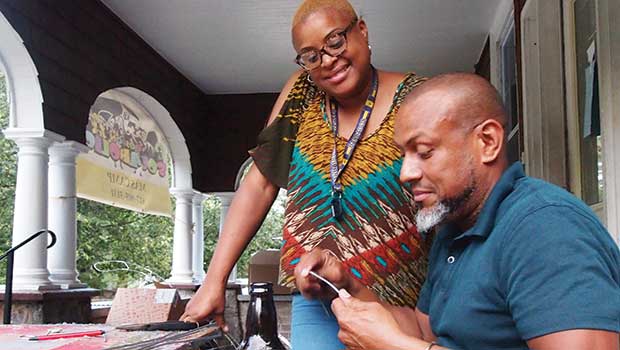

Volunteers with Soca and Associates use glue guns to affix rhinestones, sequins and other adornments to carnival costumes.
The Boston Caribbean Carnival is a beloved annual tradition filled with pounding soca music, thousands of dancing participants, brilliant colors and unbelievably extravagant costumes.
But the period leading up to the joyous celebration is no walk in the park, especially for Socaholics, one of Boston’s biggest masquerade bands.
Andrea Mercury, who founded Socaholics with her husband Ken, describes in detail the kind of work necessary to create such a fantastic and vibrant display at Carnival.
“Our team is made up of 10 dedicated members who work on making the costumes,” she said. “And we all work full-time jobs so by the time we get back from work, we continue on until one or two in the morning.”
Every year, the band makes 200 to 300 costumes to perform in, with this year having the biggest turnout of over 300 dancers.
“Especially coming down to the last month of Carnival, we end up having 16- to 18-hour days,” said Mercury, who works as an accountant for a law firm.
The costume production usually starts at least seven months in advance, but the creative process is constant. “When Carnival season ends in August, we take a month to relax, but when October comes around, we start thinking about what we’re going to do,” said Mercury.
Mercury, who was born in Barbados, started Socaholics in 2011 as a T-shirt band. Just a year later, it launched its first costume line. Kieran Prescott designs the adult costumes and Ingrid Gitten designs for kids.
At Carnival, competing masquerade bands (referred to as mas bands) are judged on their costumes and presentation. The best presentations follow a coherent and creative theme. Socaholics’ theme this year is Toxic: beautiful but deadly.

Author: PHOTO: KAREN MORALESVolunteers with Soca and Associates use glue guns to affix rhinestones, sequins and
other adornments to carnival costumes.
Band members construct and assemble the costumes at their mas camp, or costume workshop. Often located in a bandleader’s backyard, mas camps are lively and buzzing with labor and people socializing. Ken Mercury, a contractor by trade, constructed a large shed in which band members sew, glue and staple the feathers, rhinestones, streamers and glitter that make carnival costumes shine in the August sun. On the front porch of their Dorchester Victorian, Ken bends wire frames that will support some of the band’s more ambitious designs.
With just a few weeks left until Carnival, Prescott, who works in mortgage operations for a bank, is busy making costumes for the elite section of the band that will be playing vixens. Vixens are known as seductive but untrustworthy.
Prescott has been designing for Socaholics since 2013. He came up with the idea of calling the section “elite” because it only has eight dancers. “It’s the section you see first when the band comes up and they have the most exaggerated costumes,” he said.
The band has five other sections with up to 60 players. Each section will be masquerading as different creatures or humans.
“I wanted to present things of the world that are beautiful but deadly or poisonous in some way,” said Prescott.
The other five sections will be playing the mandarin fish, the viper snake, zoanthus coral (colorful but contains toxins) and the nymph.
“The costumes are pretty much made to portray what we are playing,” said Mercury. “For example, the viper section is orange, made with snake-like material.
Prescott said he is a big fan of feathers, rhinestones, patterned fabric and, this year in particular, chains. “All of the costumes this year have chains on them,” he said.
The 29-year-old head designer, who has been making costumes since he was 12, designs the prototype of each costume while the rest of the team mass produces it.
“Joining Socaholics was my first year designing my own section,” said Prescott. “It was a fresh new band and I knew I could help take it to the next level since I was new, too.”
Each section has a section leader, but separate from that, there is a King and Queen of each band.
“They choose to play it themselves,” said Mercury. “It’s the most extravagant costume, which costs a lot of money. But once they go big like that it, they love playing it.”
The Queen and King costumes are so large, they require wheels and steel frames for the dancers to dance with them.
Those playing mas in the largest costumes are entered in the King and Queen competition held on the Thursday before Carnival. The Kings and Queens of each band dance, show off their costume, and portray what they’re playing. Whoever wins is awarded money and trophies.
“And bragging rights,” said Mercury. “They can say, ‘I’m the Queen or I’m the King of Carnival.’”
Silleta Davis is this year’s Socaholics Queen. She has been with the band since it started and has grown close with the team.
“We bicker, we fight, argue, cry, laugh — everything together,” she said.
Working as a part-time Uber driver, Davis loves everything about Carnival. “The dancing in the street, the music,” she said. “To me, it’s kind of like being free.”
At the end of the day, it is a lot of work,” said Prescott. “But once you see it on the road, you know everything was worth it.
“You see everyone happy and having a great time and your creation comes together and flows,” he said.
At last year’s Boston Caribbean Carnival, Socaholics won band of the year. Mercury describes it as her happiest Carnival memory. “I accomplished my initial dream, that’s what I do this for,” she said.
The band is especially proud to have won because they were the first Barbadian band to win in Boston, as well as the youngest, having only started five years ago.
“After all this work, you want to win. That’s everyone’s goal and we did it,” said Mercury.
Now, Socaholics has its sights on doing it again.






